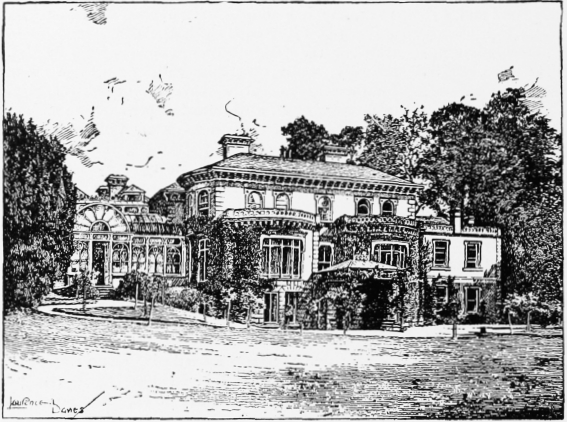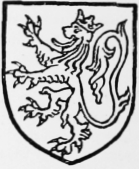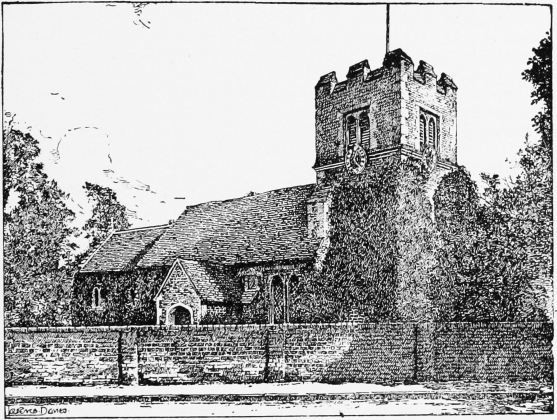A History of the County of Buckingham: Volume 3. Originally published by Victoria County History, London, 1925.
This free content was digitised by double rekeying. All rights reserved.
'Parishes: Fulmer', in A History of the County of Buckingham: Volume 3, ed. William Page( London, 1925), British History Online https://prod.british-history.ac.uk/vch/bucks/vol3/pp275-278 [accessed 15 January 2025].
'Parishes: Fulmer', in A History of the County of Buckingham: Volume 3. Edited by William Page( London, 1925), British History Online, accessed January 15, 2025, https://prod.british-history.ac.uk/vch/bucks/vol3/pp275-278.
"Parishes: Fulmer". A History of the County of Buckingham: Volume 3. Ed. William Page(London, 1925), , British History Online. Web. 15 January 2025. https://prod.british-history.ac.uk/vch/bucks/vol3/pp275-278.
In this section
FULMER
Folemere (xiii cent.); Fouwelemere, Foulmere (xiv cent.).
Fulmer is a quiet rural parish, covering 1,370 acres, of which 138 acres are arable land, 537 permanent grass and 366 woods and plantations. (fn. 1) In 1895 524 acres were included in the civil parish of Gerrard's Cross, which was created out of the parishes of Chalfont St. Peter, Fulmer, Iver, Langley Marish and Upton-cum-Chalvey. (fn. 2) The highest point is 276 ft. above the ordnance datum in the north of the parish, the lowest 125 ft. in the south. The soil is light, the subsoil gravel; the chief crops are oats, wheat, barley and grass. The little village of Fulmer lies in a hollow amid picturesque surroundings. The mere or lake from which it derives its name was in the 19th century a swamp laid out for the cultivation of water-cress. (fn. 3) At the entrance of the village, opposite Fulmer House, stands Fulmer Place, the seat of Admiral Lord John Hay. The church is close by, with its graveyard facing the school and blacksmith's forge. Next to it is the Black Horse Inn. A footpath on the other side of the church leads across the meadows to Fernacres, the property of Mr. Frederick Burt. The village street runs south of the church. Adjoining the cottages on the east side of it is the public well given in 1844 by John Kaye, and beyond them is the plain rectoryhouse. To the north-west of it stands Fulmer Hall, overlooking Stoke Common and Pickeridge Farm and wood.
Before the Inclosure Act of 1865 (fn. 4) Fulmer contained some 300 acres of common land, but this is now reduced to a small public recreation ground in the village.
MANOR
There is no mention of Fulmer in the Domesday Survey. It may, however, be identified with the 6 hides 3 virgate; in Datchet which were held before the Conquest by Siward, man of Earl Harold. (fn. 5) This land was included in the manor of 13½ hides held in Datchet in 1086 by Giles de Pinkney. (fn. 6) In the 13th century Fulmer is named as forming one fee with Datchet, (fn. 7) and in 1254 for the first time is termed FULMER MANOR. (fn. 8) The overlordship follows the same descent as Datchet Manor (q.v.) until 1472, when the latter was retained by the king. (fn. 9) From this time Fulmer appears to have been held in chief by knight service, (fn. 10) last mentioned in 1639, when Anne, widow of Sir Marmaduke Darrell, was charged with finding a lance for the manors of Missenden and Fulmer. (fn. 11)
The descent of Fulmer Manor is the same as that of Datchet (fn. 12) until 1331, when it was not restored to Edmund de Pinkney, (fn. 13) but granted by the king to William Montagu, (fn. 14) who conveyed it in 1335 to John de Moleyns. (fn. 15) From this date the descent of the manor corresponds with that of Stoke Poges (fn. 16) until it was sold by Richard Branthwaite before 1594 (fn. 17) to Sir Marmaduke Darrell. (fn. 18) In 1607 a Crown grant of Fulmer Manor was made to Sir Marmaduke Darrell, probably for assurance of title. (fn. 19) On his death in March 1631–2 (fn. 20) he was succeeded by his son Sir Sampson Darrell, kt., (fn. 21) who died three years later leaving a son and heir Marmaduke, aged fourteen. (fn. 22) He took the oath of allegiance in 1638 (fn. 23) and in 1678 united with his wife Katherine (fn. 24) and their son Marmaduke in conveying Fulmer Manor to George Castle and Richard Jones. (fn. 25) It came soon afterwards into the possession of Judge Jeffreys. (fn. 26) After the death of his son John in 1702 (fn. 27) the manor became the right of John's sisters and co-heirs, (fn. 28) Mary Dive and Margaret Stringer. (fn. 29) Mary's portion was included in the sale to the Earl of Portland in 1706 and follows the same descent as Bulstrode Park in Hedgerley. (fn. 30) (q.v.). Sir John William Ramsden, bart., is lord of the manor in Fulmer at the present time.

Fulmer Place

Darrell. Azure a lion or with a crown gules.
Margaret Stringer's portion in Fulmer Manor was conveyed in 1707 to Thomas Pickering. (fn. 31) In 1711 a warranty against all likely claimants from the Jeffreys' descendants was secured by Richard Ronnen. (fn. 32) His property corresponds to the large estate in Fulmer which was owned during the first half of the 18th century by Richard Eskrigge, Sheriff of Buckinghamshire in 1742. (fn. 33) He built Fulmer Place on the site of the manor-house of the Darrells. (fn. 34) His daughter Elizabeth married William Owen and the estate descended to their son Richard, father of the great naturalist Sir Richard Owen. (fn. 35) Richard Owen sold a portion of it, including Fulmer Place, on the expiration of a lease to William Beckwith in 1796, to William Froggatt. (fn. 36) After his death in 1809 (fn. 37) this property passed through several hands and was purchased about 1876 by Admiral Lord John Hay, (fn. 38) who is the present owner.

Willoughby, baronet. Sable a cross engrailed or, quartered with Gules a cross moline argent all within a border gobony argent and gules.
The remaining portion of Richard Eskrigge's estate with Fulmer Grove was purchased by Richard Calvert (fn. 39) about 1796. (fn. 40) He sold it in 1820 to John Kaye, who rebuilt the house in 1833. (fn. 41) John Kaye was Sheriff of Buckinghamshire in 1849 and died at Fulmer in 1861. (fn. 42) His property came into the possession of Sir John Pollard Willoughby, bart., who died at Fulmer Grove in 1866. (fn. 43) His widow, Lady Willoughby, owned Fulmer Grove, or Hall, (fn. 44) as it is now more usually called, until her death in 1910, when she was succeeded by her son Sir John Christopher Willoughby, bart.
A property in Fulmer, including a messuage and land called the Warren with 150 acres of woodland, the Park (40 acres), and Brewhouse meadow, was alienated from the manor by Marmaduke Darrell in 1655 to Sir William Bowyer. He sold it in 1676 to Henry Cave, who afterwards settled it in jointure on his son Henry, his wife and their issue. In 1683 the Caves, father and son, filed a bill in Chancery against Anne, widow of James Harrington, who in 1681 (but not previously) had claimed this property in virtue of an agreement made in 1652 with her brother, Marmaduke Darrell. (fn. 45)
The usual manorial court was held at Fulmer (fn. 46) every three weeks. (fn. 47) The view of frankpledge granted to John de Moleyns in 1338 (fn. 48) was held twice a year. (fn. 49) Frequent grants of the right of free warren were made to successive owners during the 13th and 14th centuries. (fn. 50) Other rights granted to John de Moleyns in 1337 were the return and execution of writs, the execution of malefactors and the assize of bread and ale. (fn. 51) All manorial rights in Fulmer as held by John de Moleyns 'or any other person' were included in the grant to Sir Marmaduke Darrell in 1607. (fn. 52)
In 1332 Edmund de Pinkney held some tenements in Fulmer of the manor of Temple Bulstrode in Hedgerley by service of 6s. and a pound of wax yearly and suit of court every three weeks. (fn. 53)
CHURCH
The church of ST. JAMES is a small building consisting of chancel, nave, north porch, south aisle, and west tower.
The whole church was rebuilt by Sir Marmaduke Darrell in 1610. The present nave, west tower and porch are of this date, but the chancel, south aisle and vestry were built between 1877 and 1884. The walling is of brick with plaster and stone dressings. The roofs are covered with tiles.
In the north wall of the nave are two early 17th-century square-headed windows, the eastern of which is of three pointed lights and has four medallions of original glass depicting allegorical subjects. The western window is of two similar lights, and between them is the north doorway, which has an oak frame and a mediaeval door with original strap hinges probably re-used from the earlier church. The south arcade of three bays is modern and the pointed tower arch is covered with plaster. The tower is of three stages with angle buttresses and an embattled parapet; there are pointed windows in the west wall of the first and second stages, and the bell-chamber windows are each of two pointed lights. The gabled north porch has an outer archway with a depressed head and an original moulded and battened door. The nave roof dates probably from the early 17th century and has a plastered ceiling following the line of the collar beams.

Fulmer Church from the North-west
In a recess in the chancel is the tomb of Sir Marmaduke Darrell, kt. (d. 1631), lord of the manor of Fulmer and 'founder of this church,' who served in the household of Queen Elizabeth, and was afterwards cofferer to James I and Charles I. The monument also commemorates Anne his first wife, daughter of John Lennard of 'Knol' in Kent, and Mary their daughter, wife of Sir Robert Gorges, kt. On the tomb are the recumbent effigies of the knight, in plate armour, and his wife, and in front are kneeling figures, probably of his two sons with their wives and children. Above the recess are allegorical figures and a shield of arms, on either side of which is a funeral helm. The colouring and gilding are modern.
There is a ring of six bells: the treble, inscribed in black letter 'Sancta Maria ora pro nobis,' is probably by John Sanders, about 1540; the second is by Thomas Lester, 1741; the third and tenor by John Warner & Sons, 1884; the fourth and fifth are by Richard Eldridge, 1617, and are inscribed in black letter 'Lord plead my cause' and 'Our hope is in the Lord.'
The plate consists of a chalice and paten of the early 18th century and modern flagon and almsdish.
The registers begin in 1688.
ADVOWSON
In 1291 Fulmer was a chapelry annexed to Datchet Church. (fn. 54) It was made a parochial church and rectory and endowed with the great tithes of Fulmer by the Dean and Canons of Windsor in 1553. (fn. 55) Its valuation in 1786 was £61 13s. (fn. 56) The descent of the advowson is the same as that of Datchet (q.v.) until 1905, (fn. 57) when it passed from the Dean and Canons of Windsor to the Bishop of Oxford. (fn. 58)
CHARITIES
The charity of Sir Marmaduke Darrell, kt., cofferer of the Royal Household, founded by deed 6 November 1629, consists of an annuity of £26 4s. issuing out of certain lands in the parishes of Iver and Langley Marish, of which £5 was to be paid to the incumbent and churchwardens, to be employed towards the restoration of the parish church and towards the provision of books and ornaments, or putting forth apprentices or for marriage portions, £20 12s. for the distribution of bread to poor householders, and 12s. in the purchase of three pairs of gloves to be presented to the Dean of the Free Chapel of St. George, Windsor, to the senior resident canon and to the incumbent for their supervision. The gloves are no longer presented, the income being now applied in the distribution of bread, in the supply of books for church use and in a donation to the coal club. Under the head of 'Bread Money' a further sum of £2 a year is paid out of the Fernacres estate and distributed at Christmas.
In 1837 Ann Champnes, by her will, bequeathed a sum of money, now represented by £160 12s. 10d. consols, the income, amounting to £4 0s. 4d., to be applied annually in clothes for eight girls attending Sunday school.
The sum of stock is held by the official trustees, who also hold a sum of £333 6s. 8d. consols, producing £8 6s. 8d. yearly, in trust for Kaye's Educational Foundation, and £666 13s. 4d. consols, producing £16 13s. 4d. yearly, applicable in the distribution of coals, bread and money. These trust funds were derived under codicils to the will of John Kaye, proved in 1861.
